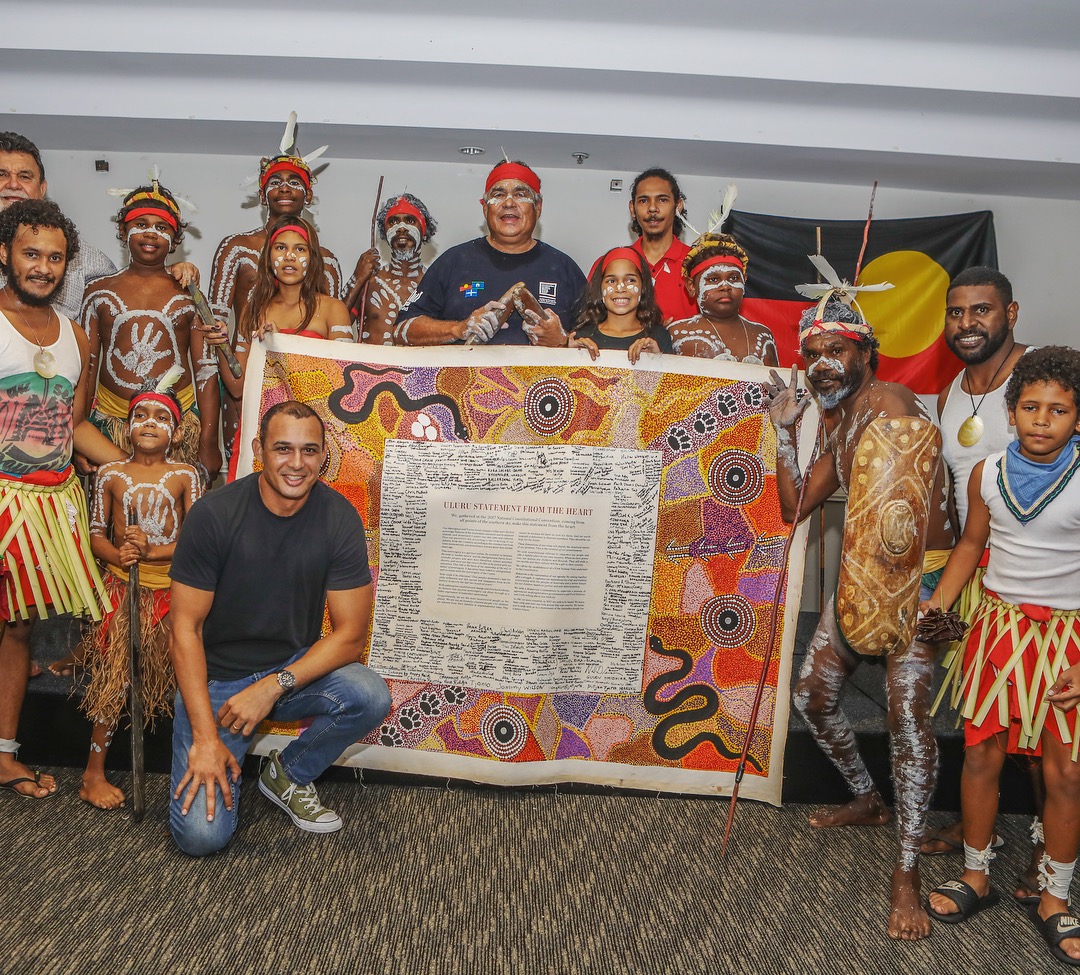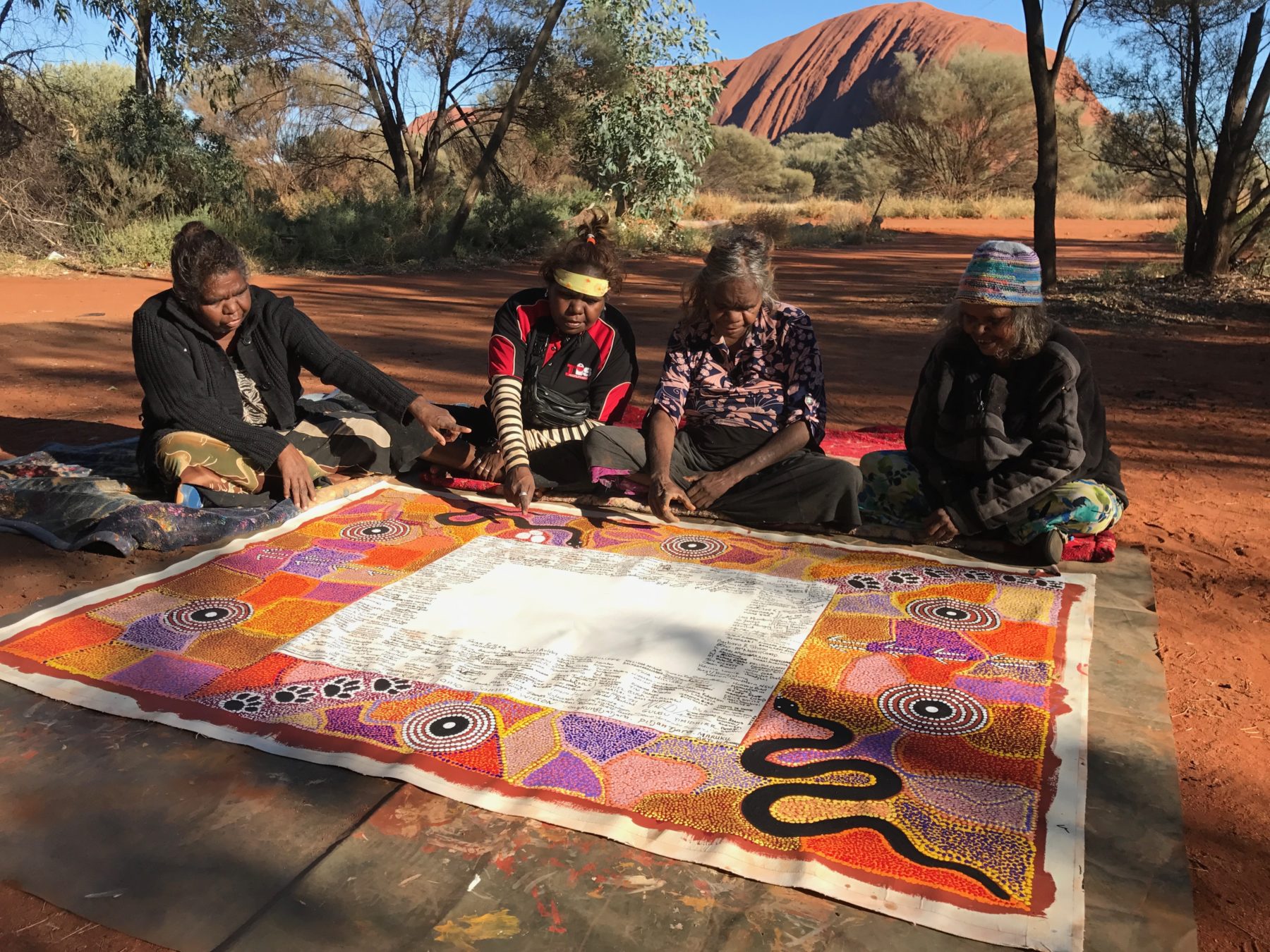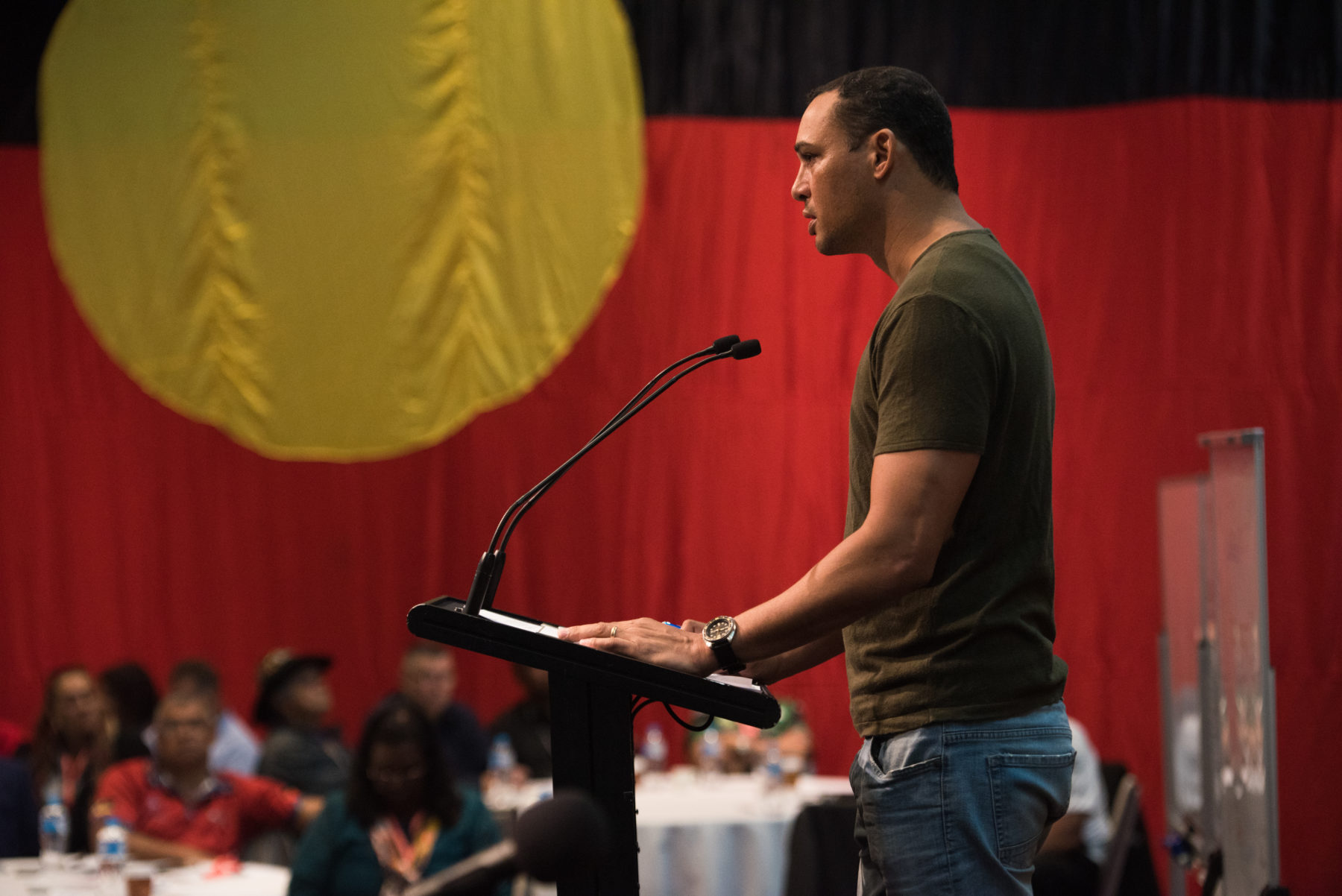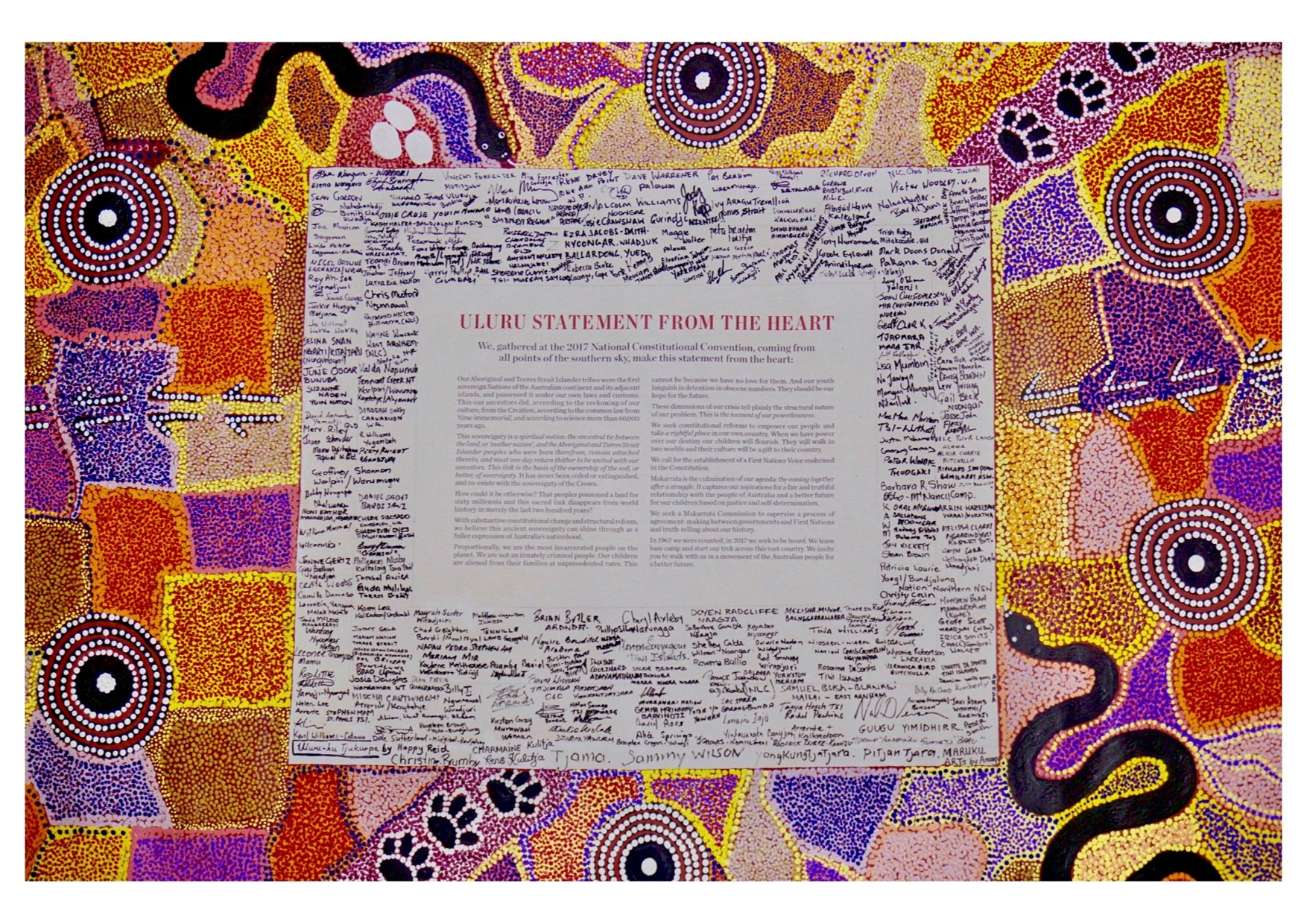The Uluru Statement from the Heart is a sacred First Nations’ invitation to the Australian people. It was conceived on 26 May 2017 from the collective experiences of Aboriginal and Torres Strait Islander peoples during an unprecedented process of dialogue and consensus building. Forged from more than two centuries of hardship and struggle, the Uluru Statement gives hope to a nation born from many nations, that we may find our collective heart.
The eloquent words of the Uluru Statement make an affirmation that the first sovereign nations of the Australian continent and its adjacent islands have never ceded sovereignty – not when first colonised by the British, and not with the enactment of the Australian Constitution in 1901. The words remind us that neither colonisation nor the federation of those early colonies could extinguish the sacred link that no other civilisation on Earth can claim – that the Aboriginal and Torres Strait Islander peoples are born from, remain attached to, and will return thither to, Country, to be united with ancestors stretching back an amazing 60,000 years. At the same time, the Uluru Statement acknowledges the sovereignty that we all share, as citizens of Australia.
In haunting prose, and with First Nations Voices that sing as a chorus, the Uluru Statement decries the scale of our crisis – disproportionate incarceration rates that are the worst in the world; our children, aliened from their families and culture; our youth, languishing in detention in obscene numbers – the awful effects of intergenerational trauma and systemic powerlessness writ large in the official statistics of Australia. It should be obvious that these dimensions of our crisis are not due to a genetic propensity to crime, nor to a lack of love and care for our own. But sadly, it seems it hasn’t been obvious in Australia, where there is still a toxic inertia that perpetuates the “great Australian silence”.
In the Uluru Statement, First Nations people did more than lament our present and our past; we did not write it to simply stir empathy. On 26 May 2017, through the Uluru Statement, Aboriginal and Torres Strait Islander peoples gifted all Australians with their vision – a road map to find the heart of the nation.
The Uluru Statement from the Heart was made through a process that imbued it with unprecedented cultural authority. Further, it carries the name of a sacred place and was given its name – Uluru – from those Elders of the Mutitjulu community who are its cultural guardians. They gave the name to the Statement because they want its proposals to succeed.
The Uluru Statement makes three very important proposals that will be transformative. They are in sequence: first, for a First Nations Voice enshrined in the Constitution; second, for a Makarrata Commission to supervise agreement-making, or treaties; and third, to oversee a process of truth-telling for the nation.

The establishment of a First Nations Voice enshrined in the Constitution is the priority reform – indeed it is now an urgent reform – because, unlike other racial or ethnic groups, laws and policies are being made by governments specifically about us, without us, and too often to our detriment. A Voice is the first reform because it will start to address this political disempowerment, setting us on the path for the future reforms of Treaty and Truth.
When we gifted Australia with the Uluru Statement from the Heart, we struggled to be heard. The federal government almost immediately dismissed it, and there was no money for a campaign.
With the support of First Nations Elders and my union, the Maritime Union of Australia, I decided to travel the country with the canvas on which the Uluru Statement is written. I showed the artwork, the signatures and the words to thousands of people. I shared what I had heard, seen and felt at Uluru with small crowds in remote places, such as ancient meeting places like Yule River in the Pilbara, and densely populated places, including the capital cities. With other passionate Indigenous change-makers, I took the Uluru Statement to the people, and we started a people’s movement.
In June 2018, after 12 months on the road with the Uluru Statement canvas, I realised I had a compelling story to tell. I had met many Aboriginal and Torres Strait Islander people who had unique stories and perspectives that I thought should be heard. I thought of the idea of sharing these stories in a book. When I discussed the idea with Marcia Langton, who had just written her book Welcome to Country, she immediately encouraged me to start writing. So I did.
We invite you to walk with us in a movement of the Australian people for a better future.”
THOMAS MAYO
Twelve months later, I published my book. I gave it the title: Finding the Heart of the Nation – The Journey of the Uluru Statement Towards Voice, Treaty and Truth. It became an Australian bestseller – an important handbook for people to learn about the Uluru Statement and why Aboriginal and Torres Strait Islander people support it. Along with my story and the stories of 20 other First Nations people from a variety of backgrounds and age groups, and from all around the country, I narrated our journey of struggle and hope. I wrote about our many challenges and achievements. Most importantly, I wrote a book that will teach you why you should walk with us.
Finding the Heart of the Nation is now in its second edition, published this month (August 2022) by Hardie Grant. It comes at a crucial time. Australians have elected a new prime minister, Anthony Albanese, who has demonstrated a capacity to listen to First Nations people. With the minister for Indigenous Australians, Linda Burney, and the Special Emissary for Reconciliation and Implementation of the Uluru Statement from the Heart, Pat Dodson, the Prime Minister has made the commitment to hold a First Nations Voice referendum, just as my people invited the federal government to do in 2017.
A referendum is imminent.

Many Australians have taken up the invitation to walk with First Nations people to establish a First Nations Voice in the constitution. Polling has indicated that as the Australian people learn about the proposal and how it came from the wonderful Indigenous consensus in the Uluru Statement from the Heart, the chance of a successful referendum grows. The following is some simple information that will help you understand, not so much for your reading pleasure, but because I hope you will help us convince others to vote “Yes”, as I hope you will too.
What is constitutional recognition?
Put simply, the Constitution is the rule book of the nation. It is the highest of written laws that determine how all other laws are made, and by whom – the state or federal parliaments. As the foundational document for the Australian Federation or, as some describe it, the birth certificate of our modern nation, above all other laws and decrees, the Constitution defines our modern nation. Yet it does not recognise Indigenous people.
Who would say that First Nations people – a people and a culture that has lived and flourished on and with this country for tens of thousands of years – should not be included in Australia’s Constitution? Australia’s forefathers may have denied this, and did so violently. But today, Australia can be different.
For our ‘young’ nation to mature, constitutional recognition is vital. It is a matter for all of us – a chance to redefine our Australian identity and to right a wrong from the past.
When Australia embraces the longest continuing culture on the planet as what constitutes us – the building blocks of our national DNA – we will share a unique identity in the world – an identity we can all be proud of.
To achieve constitutional recognition, first, those to be recognised should determine how they are recognised. Australia’s Indigenous peoples have chosen to be recognised by establishing a constitutionally enshrined Voice. Finally, a referendum must be held, asking the Australian people a question that is as simple as this: Do you support an alteration to the Constitution that establishes an Aboriginal and Torres Strait Islander Voice?
For constitutional recognition, the Australian people must vote “Yes”.
What do we mean by Voice?
The Uluru Statement from the Heart calls for a substantive form of recognition: “We call for the establishment of a First Nations Voice enshrined in the Constitution.”
A “First Nations Voice” is a First Nations representative body with a constitutional guarantee that it may provide advice to Parliament. Our people decided that the political power to influence decisions made about us – decisions that affect our health, our livelihoods, our wellbeing and justice – is the most important step to progress our interests.
Is a Voice a third chamber in Parliament?
We do not propose to establish a third chamber in Parliament, or a right to veto the passing of legislation. We do not propose to alter or hinder existing government processes. We understand such a proposal would not succeed at a referendum. Claiming that this is what First Nations people want has been used as a scaremongering tactic by those who oppose Indigenous rights.
We decided the political power to influence decisions about us was the most important step to progress our interests.”
THOMAS MAYO
Why must we constitutionally enshrine the Voice?
All past national First Nations representative bodies have been repealed or defunded when hostile governments have been elected. We have learnt that we must protect our Voice so that it cannot be silenced.
The example that is most often recalled in this respect is the Aboriginal and Torres Strait Islander Commission (ATSIC). This was established in legislation by the Bob Hawke Labor government in response to the 1988 Barunga Statement. The John Howard Liberal National Opposition vehemently opposed its establishment. When Howard led the Coalition to government in 1996, he immediately defunded ATSIC. He shut the representative body down completely in 2005 with the support of the Labor Opposition, even though Professor Jackie Huggins, John Hannaford and Bob Collins had just completed a wide-ranging review of the organisation. Their report made recommendations to address the challenges ATSIC was facing. Rather than working with First Nations people to improve ATSIC, the government destroyed it.
It was easy for a hostile federal government to silence ATSIC because it was merely an Act of Parliament. Constitutional enshrinement of a Voice is different. It can only be achieved by way of a referendum, not by an Act of Parliament. A successful referendum will make it a permanent and politically strong voice. It will speak with a mandate from the Australian people that must be heard. And because it will be irremovable, it can therefore be unapologetic in its advocacy.
How does a Voice help our people?
It is important to recognise what happens when our Voice is silenced. In the absence of a Voice with an ability to effectively hold politicians to account, and to influence the decisions they make, they will continue to fail and harm us.
Every year, the annual Closing the Gap health strategy targets for reduced incarceration rates, levels of education, employment and improved life expectancy are dismally missed. The gap is getting wider. As the Uluru Statement says: “This is the torment of our powerlessness.” Without the political power a Voice provides, we will continue to slip backwards. We know that gains made under a reasonably benevolent government can easily be lost the next time a hostile government is elected.
A Voice to Parliament is a practical reform, not merely symbolic, as some have argued, because policy and legislation decisions in Canberra affect everything we struggle with – housing, policing, healthy food affordability, community infrastructure – the list goes on. And it all affects the ability to close the gap.
A Voice to Parliament would also support our ability to protect and care for Country.
Gaining greater ability to influence the decisions made about us is the most practical reform that can be made in a democracy.
Is introducing a First Nations representative body into the Constitution racist?
Many Australians are unaware that the federal Parliament has the explicit power to make special laws about First Nations people based on our ‘race’. This is in Section 51 (xxvi) of the Constitution of Australia, known as the “Race Power”.
Indeed, because of this power, Australia’s Constitution allows Parliament to be racist. And this Race Power has only ever been used to make special laws about Aboriginal and Torres Strait Islander people. As in the High Court’s Hindmarsh Bridge case, the Race Power may be used to the detriment of Indigenous people, not necessarily to our benefit.
While “Indigenous peoples” are not a “race” different from other humans, our unique connection to Country, culture and experience of colonisation is substantive and deserving of recognition. The Uluru Statement does not propose to remove the Race Power, though. This is because some beneficial laws, such as Native Title legislation, would be jeopardised by its removal. We also do not propose to replace the word “race” with ‘Indigenous people’. Such tinkering does not empower us. We proposed a more urgent and useful amendment. We seek to establish the representative body, the First Nations Voice, to monitor the use of the Race Power and to influence its use to benefit us and to ensure it is not used to harm us again. A Voice is important for guiding Parliament, and also useful for holding politicians to account for the decisions they make.
Aren’t First Nations people already equal? Instead of a First Nations Voice to Parliament, why don’t Indigenous people just get elected?
Some people who oppose the Voice to Parliament proposal argue that Indigenous people already enjoy the right to vote and the ability to run for Parliament. This ignores the fact that Indigenous people are 3 per cent of the population, spread across hundreds of electorates. We are swamped by the priorities of the other 97 per cent. It also ignores that our Indigenous candidates are chosen in preselection processes that rarely involve Indigenous people. And, if elected, Indigenous members are outnumbered in Parliament and are answerable to a mostly non-Indigenous electorate. Again, First Nations people are powerless in this democracy, and subject to the whims of a Parliament that we cannot hold to account.

What does the Voice representative model look like?
The constitutional amendment will be simple. It will establish that there will be recognition of First Nations people through a Voice to Parliament and that the advice First Nations people give is not justiciable. Once passed by the referendum, these aspects of the Voice to Parliament will be set in stone. The model, however, will be legislated so that it may evolve with the needs of the people. This flexibility is important to the continuous improvement of the Voice, and so it may evolve with the needs of the people.
The proposal for a Voice isn’t new and it isn’t too much to ask. First Nations people have been struggling for fairly chosen representation and the right to self-determination since before Federation. This aspiration has been recorded in numerous statements and petitions, such as the 1938 Day of Mourning, the 1963 Yirrkala Bark Petitions, the 1972 Larrakia Petition, the 1988 Barunga Statement and today, the Uluru Statement from the Heart.
Simply put, we are establishing a representative body, common in a representative democracy. It is consistent with how politics has always been done in Australia.
What will a Makarrata Commission do?
Makarrata is a Yolŋu word for a process of “coming together after a struggle”. In this ancient and continuing dispute resolution process, the parties must bring truthfulness and a genuine intent to reach a settlement on how the wrongs of the past will be resolved. At the completion of this process, relations are strengthened and peace prevails. Makarrata has long been used by First Nations leaders to describe our aspirations for a settlement that improves relations and heals the wounds of the past.
It is envisioned that the Makarrata Commission would supervise, promote and assist truth-telling to the nation. It may also act as an umpire and mediator as First Nations negotiate agreements, such as treaties, with governments.
The Makarrata Commission needs only to be legislated. It will be separate from the Voice with no constitutional change required. To develop the best powers and functions of the Makarrata Commission, the constitutionally enshrined Voice should be established first so First Nations representatives will be in a position to influence its development.

Uluru Statement from the Heart
We, gathered at the 2017 National Constitutional Convention, coming from all points of the southern sky, make this statement from the heart:
Our Aboriginal and Torres Strait Islander tribes were the first sovereign nations of the Australian continent and its adjacent islands, and possessed it under our own laws and customs. This our ancestors did, according to the reckoning of our culture, from the creation. According to the common law, from time immemorial. And according to science more than 60,000 years ago.
This sovereignty is a spiritual notion. The ancestral tie between the land or Mother Nature, and the Aboriginal and Torres Strait Islander people who were born therefrom, remain attached thereto, and must one day return thither to be united with our ancestors. This link is the basis of the ownership of the soil, or better, of sovereignty. It has never been ceded or extinguished. And it coexists with the sovereignty of the Crown.
How could it be otherwise? That a peoples possessed a land for sixty millennia and this sacred link should disappear in merely the past 200 years.
With substantive constitutional change and structural reform we believe this ancient sovereignty will shine through as a fuller expression of Australia’s nationhood.
Proportionately, we are the most incarcerated people on the planet. We are not an innately criminal people. Our children are aliened from their families at unprecedented rates. This cannot be because we have no love for them. And our youth languish in detention in obscene numbers. They should be our hope for the future.
These dimensions of our crisis tell plainly the structural nature of our problem. This is the torment of our powerlessness.
We seek constitutional reforms to empower our people and take a rightful place in our own country. When we
have power over our destiny, our children will flourish, they will walk in two worlds, and their culture will be a gift to their country.
We call for the establishment of a First Nations Voice enshrined in the Constitution.
Makarrata is the culmination of our agenda: the coming together after a struggle. It captures our aspirations for a fair and truthful relationship with Australia and a better future for our children based on justice and self-
determination.
We seek a Makarrata Commission to supervise a process of agreement making between governments and First Nations, and truth-telling about our history.
In 1967 we were counted, in 2017 we seek to be heard. We leave base camp and start our trek across this vast country. We invite you to walk with us in a movement of the Australian people for a better future.

Finding the Heart of the Nation
The journey of the Uluru Statement towards Voice, Treaty and Truth
In this updated edition of his bestselling book, Thomas gets behind the politics and legal speak to explain why the Uluru Statement from the Heart is an invitation to all Australians. Completing his writing just after the 2022 federal election, Thomas has included a new introduction and conclusion, as well as a call to action for all Australians.
Available for pre-order here.



